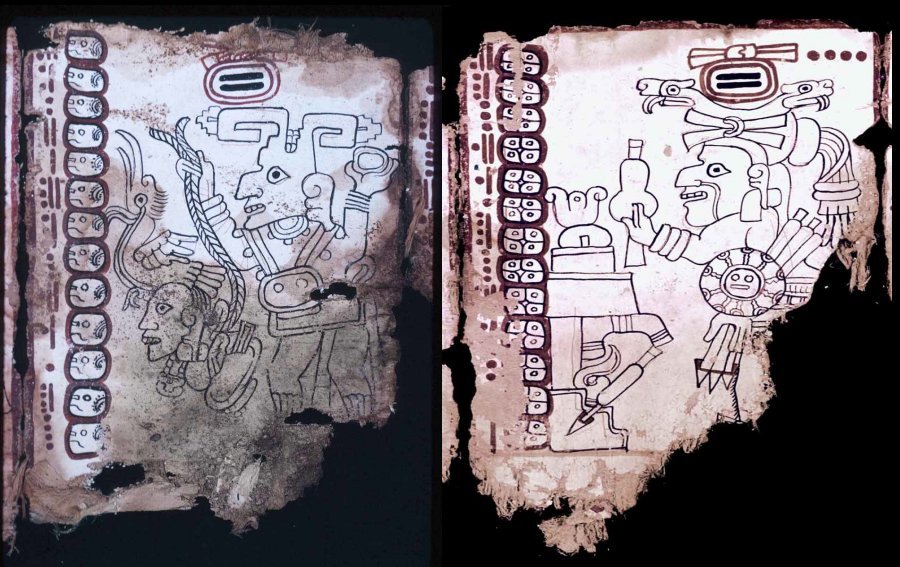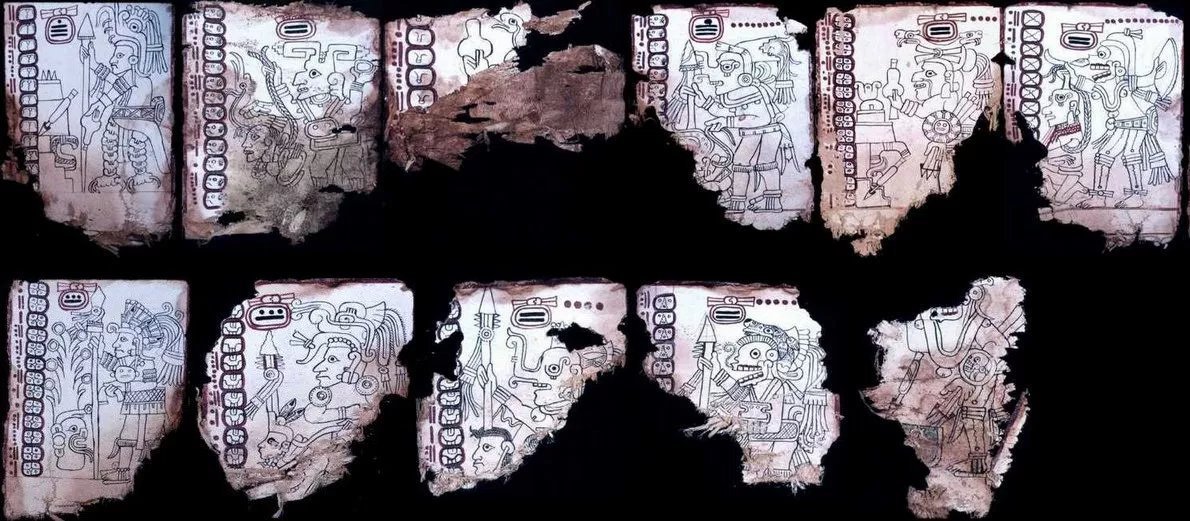Grolier Codex – Oldest, Unique, Genuine Pre-Columbian Maya Manuscript That Survived Spanish Inquisition
A. Sutherland - AncientPages.com - The ancient Maya created many books, but almost all of them were burned by conquistadors and clergy. One of those who significantly contributed to the destruction of the Maya cultural material was the Yucatan bishop Diego de Landa (1524 – 1579).
Left: Page 6 of the Grolier Codex, depicting a death god with captive. Image credit: Private Collection via Wikipedia; Right: Codex Grolier. Image credit: Instituto Nacional de Antropología e Historia, Mexico
The original manuscript has been lost in the "Relación de las Cosas de Yucatán" (around 1566), but many copies still exist; de Landa wrote valuable information about the religion, language, and culture of the Maya.
However, during the ceremony on July 12, 1562, many Maya codices (according to Landa, 27 books) and approximately 5000 Maya cult images were destroyed by the Inquisition Tribunal called by the bishop.
It first appeared in a private collection in the 20th century and was displayed at the Grolier Club in New York. The codex consists of a fragment of a Maya book, containing almanacs of Venus represented in a somewhat simplified fashion, compared to the known Maya codices.
The Grolier Codex would be only the fourth surviving pre-Columbian Maya book if genuine. The manuscript would once have measured 250 centimeters (98.4 in), and was approximately the size of the Dresden Codex.
Codex Grolier, page 7. Upploaded by Adamt - Public Domain
Looters discovered it in a cave in Chiapas, Mexico, in the 1960s. After careful studies, this important manuscript has been confirmed as genuine and probably the most ancient of all surviving manuscripts from old America.
tored in the treasury at the National Anthropological Museum, Mexico, the Grolier Codex contains little text and a lot of illustrations.
Only a fragment of the Codex survived. It consists of 10 painted pages ornamented with ritual Maya iconography, tablets of Venus covering 104 years (probably three generations of the Maya priests), and a calendar that charts the movement of the planet Venus.
Venus and its cycles were significant for the Maya and all Mesoamerican peoples, who believed that different gods and deities were strongly associated with these cycles and with the passing of time.
Codex Grolier. Image credit: Instituto Nacional de Antropología e Historia, Mexico
The Maya regularly measured Venus' cycles because it could help them organize ritual cycles based on astronomical phenomena.
The Grolier Codex differs much from the Dresden Codex, which mentions a great variety of Maya gods and consists of many calculations and detailed notes made by its authors.
Instead, the Grolier Codex only describes the gods who are "deities of everyday life" of the Maya people. These gods are responsible for events such as death, sunlight, or lightning phenomenon, strongly associated with K'awiil, a Maya deity identified with lightning, maize, serpents, and fertility.
The Maya were excellent astronomers who recorded and interpreted every aspect of the sky. They had their solar calendar and knew the timing of the eclipses. The stars, moons, sun, and planets were regarded as gods.
These Gods were involved in human affairs, and their movements were watched closely. The Maya dedicated much time to studying celestial objects, and several of their most important buildings were constructed with astronomy in mind.
Written by A. Sutherland AncientPages.com Staff Writer
Updated on January 12, 2023
Copyright © AncientPages.com All rights reserved. This material may not be published, broadcast, rewritten or redistributed in whole or part without the express written permission of AncientPages.com
Expand for referencesMcClellan J. E. Dorn H. Science and Technology in World History
More From Ancient Pages
-
 Prehistoric Legacy Of The Mysterious Burnt City
Civilizations | Jan 22, 2021
Prehistoric Legacy Of The Mysterious Burnt City
Civilizations | Jan 22, 2021 -
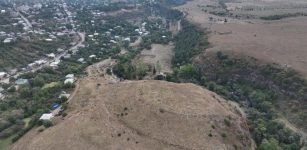 Why Was The Dmanisis Gora Fortress Community So Resilient In The Transition From The Bronze To Iron Age
Archaeology | Jun 5, 2023
Why Was The Dmanisis Gora Fortress Community So Resilient In The Transition From The Bronze To Iron Age
Archaeology | Jun 5, 2023 -
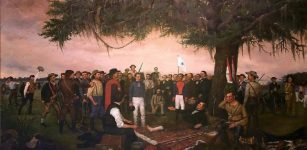 Texas Revolution – A Courageous Fight For Independence
Featured Stories | May 30, 2019
Texas Revolution – A Courageous Fight For Independence
Featured Stories | May 30, 2019 -
 Ancient Town’s Destruction Dated With Help Of Chicken Bones And Snail Shells
Archaeology | Aug 17, 2022
Ancient Town’s Destruction Dated With Help Of Chicken Bones And Snail Shells
Archaeology | Aug 17, 2022 -
 Sodré Astrolabe, Found On Portuguese Armada Shipwreck Is The Oldest In The World
Archaeology | Mar 19, 2019
Sodré Astrolabe, Found On Portuguese Armada Shipwreck Is The Oldest In The World
Archaeology | Mar 19, 2019 -
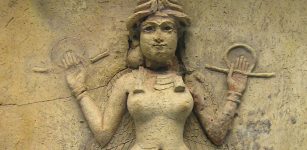 In Ancient Mesopotamia, Sex Among The Gods Shook Heaven And Earth
Featured Stories | Oct 8, 2022
In Ancient Mesopotamia, Sex Among The Gods Shook Heaven And Earth
Featured Stories | Oct 8, 2022 -
 Mystery Of Panxian Cave: How Could Gigantic Animals Reach A Mountain Cave Located Over 1600m Above Sea Level?
Featured Stories | Jul 1, 2014
Mystery Of Panxian Cave: How Could Gigantic Animals Reach A Mountain Cave Located Over 1600m Above Sea Level?
Featured Stories | Jul 1, 2014 -
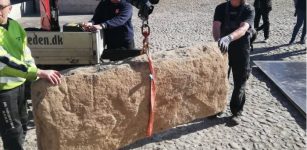 Huge Rare Runestone Found Under The Kitchen Floor In Randers Investigated
Archaeology | Jun 8, 2023
Huge Rare Runestone Found Under The Kitchen Floor In Randers Investigated
Archaeology | Jun 8, 2023 -
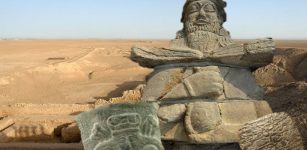 Enmerkar: Legendary Sumerian Founder And Ruler Of Uruk And Grandson Of God Utu
Featured Stories | Mar 23, 2020
Enmerkar: Legendary Sumerian Founder And Ruler Of Uruk And Grandson Of God Utu
Featured Stories | Mar 23, 2020 -
 Two 1,800-Year-Old Sarcophagi Of Wealthy People Accidentally Found At Ramat Gan Safari Park
Archaeology | Feb 22, 2021
Two 1,800-Year-Old Sarcophagi Of Wealthy People Accidentally Found At Ramat Gan Safari Park
Archaeology | Feb 22, 2021 -
 Mysterious Ancient Remains Of The Lady In The Well – An Archaeological Detective Story
Archaeology | Sep 11, 2020
Mysterious Ancient Remains Of The Lady In The Well – An Archaeological Detective Story
Archaeology | Sep 11, 2020 -
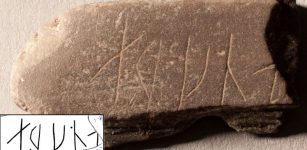 Puzzling Runic Inscription Dated To 1050-1500 AD Unearthed In Oslo, Norway
Archaeology | Dec 13, 2017
Puzzling Runic Inscription Dated To 1050-1500 AD Unearthed In Oslo, Norway
Archaeology | Dec 13, 2017 -
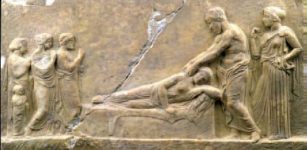 Asclepius Sanctuary On Acropolis Slope Will Be Restored
Archaeology | Jan 3, 2016
Asclepius Sanctuary On Acropolis Slope Will Be Restored
Archaeology | Jan 3, 2016 -
 What Can Ancient Toilets Teach Us About Maya Life And Tamales?
Archaeology | Jun 9, 2022
What Can Ancient Toilets Teach Us About Maya Life And Tamales?
Archaeology | Jun 9, 2022 -
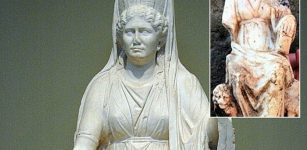 Marble 2th Century AD Statuette Of Goddess Cybele Unearthed In Bulgaria’s Plovdiv
Archaeology | Nov 5, 2019
Marble 2th Century AD Statuette Of Goddess Cybele Unearthed In Bulgaria’s Plovdiv
Archaeology | Nov 5, 2019 -
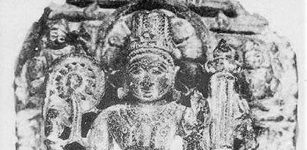 Dwarka – Pre-Harappan City That Could Rewrite The History Of The World
Civilizations | Aug 19, 2014
Dwarka – Pre-Harappan City That Could Rewrite The History Of The World
Civilizations | Aug 19, 2014 -
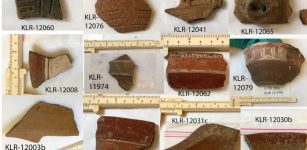 Surprising Diversity Of Ethnic Groups In The US Virgin Islands Before Columbus – New Study
Archaeology | May 18, 2023
Surprising Diversity Of Ethnic Groups In The US Virgin Islands Before Columbus – New Study
Archaeology | May 18, 2023 -
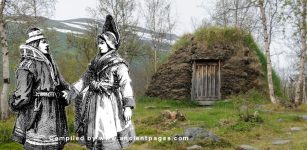 Unexpected Historical Discovery: Remains Of Famous Sami Woman Recovered
Archaeology | Aug 22, 2022
Unexpected Historical Discovery: Remains Of Famous Sami Woman Recovered
Archaeology | Aug 22, 2022 -
 Reconstructed Roman Gateway Tells The Story Of Britain’s Invasion
Featured Stories | Aug 26, 2023
Reconstructed Roman Gateway Tells The Story Of Britain’s Invasion
Featured Stories | Aug 26, 2023 -
 Babylonians And Sumerians Had Advanced Knowledge Of Astronomy
Civilizations | Feb 28, 2017
Babylonians And Sumerians Had Advanced Knowledge Of Astronomy
Civilizations | Feb 28, 2017

